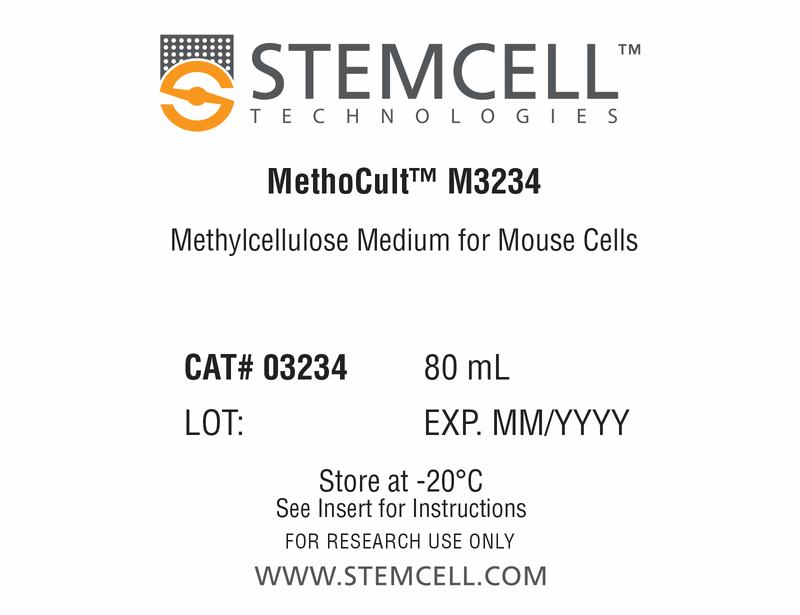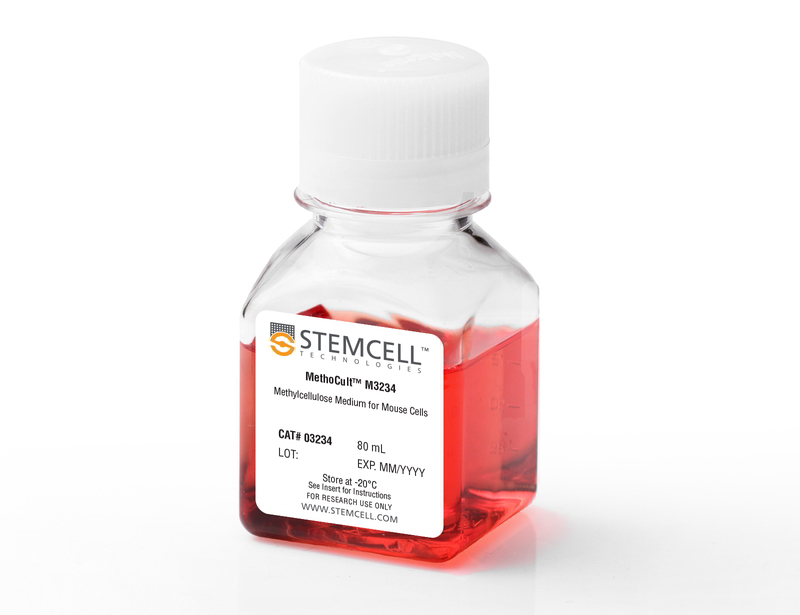MethoCult™ M3234
Methylcellulose-based medium without cytokines (including EPO) for mouse cells
概要
MethoCult™ M3234 is an incomplete medium formulation that contains methylcellulose in Iscove's MDM. MethoCult™ M3234 is suitable for the growth and enumeration of hematopoietic progenitor cells in colony-forming unit (CFU) assays of mouse bone marrow, spleen, peripheral blood, and fetal liver, when the appropriate growth factors and supplements are added. This formulation does not contain erythropoietin or other cytokines.
Browse our Frequently Asked Questions (FAQs) on performing the CFU assay.
Browse our Frequently Asked Questions (FAQs) on performing the CFU assay.
Contains
• Methylcellulose in Iscove's MDM
• Fetal bovine serum
• Bovine serum albumin
• Recombinant human insulin
• Human transferrin (iron-saturated)
• 2-Mercaptoethanol
• Supplements
• Fetal bovine serum
• Bovine serum albumin
• Recombinant human insulin
• Human transferrin (iron-saturated)
• 2-Mercaptoethanol
• Supplements
Subtype
Semi-Solid Media, Specialized Media
Cell Type
Hematopoietic Stem and Progenitor Cells
Species
Mouse
Application
Cell Culture, Colony Assay, Functional Assay
Brand
MethoCult
Area of Interest
Stem Cell Biology
技术资料
| Document Type | 产品名称 | Catalog # | Lot # | 语言 |
|---|---|---|---|---|
| Product Information Sheet | MethoCult™ M3234 | 03234 | All | English |
| Manual | MethoCult™ M3234 | 03234 | All | English |
| Safety Data Sheet | MethoCult™ M3234 | 03234 | All | English |
数据及文献
Publications (37)
Nature 2018 FEB
Population snapshots predict early haematopoietic and erythroid hierarchies.
Abstract
Abstract
The formation of red blood cells begins with the differentiation of multipotent haematopoietic progenitors. Reconstructing the steps of this differentiation represents a general challenge in stem-cell biology. Here we used single-cell transcriptomics, fate assays and a theory that allows the prediction of cell fates from population snapshots to demonstrate that mouse haematopoietic progenitors differentiate through a continuous, hierarchical structure into seven blood lineages. We uncovered coupling between the erythroid and the basophil or mast cell fates, a global haematopoietic response to erythroid stress and novel growth factor receptors that regulate erythropoiesis. We defined a flow cytometry sorting strategy to purify early stages of erythroid differentiation, completely isolating classically defined burst-forming and colony-forming progenitors. We also found that the cell cycle is progressively remodelled during erythroid development and during a sharp transcriptional switch that ends the colony-forming progenitor stage and activates terminal differentiation. Our work showcases the utility of linking transcriptomic data to predictive fate models, and provides insights into lineage development in vivo.
Blood 2011 MAY
Requirement for Dot1l in murine postnatal hematopoiesis and leukemogenesis by MLL translocation.
Abstract
Abstract
Disruptor of telomeric silencing 1-like (Dot1l) is a histone 3 lysine 79 methyltransferase. Studies of constitutive Dot1l knockout mice show that Dot1l is essential for embryonic development and prenatal hematopoiesis. DOT1L also interacts with translocation partners of Mixed Lineage Leukemia (MLL) gene, which is commonly translocated in human leukemia. However, the requirement of Dot1l in postnatal hematopoiesis and leukemogenesis of MLL translocation proteins has not been conclusively shown. With a conditional Dot1l knockout mouse model, we examined the consequences of Dot1l loss in postnatal hematopoiesis and MLL translocation leukemia. Deletion of Dot1l led to pancytopenia and failure of hematopoietic homeostasis, and Dot1l-deficient cells minimally reconstituted recipient bone marrow in competitive transplantation experiments. In addition, MLL-AF9 cells required Dot1l for oncogenic transformation, whereas cells with other leukemic oncogenes, such as Hoxa9/Meis1 and E2A-HLF, did not. These findings illustrate a crucial role of Dot1l in normal hematopoiesis and leukemogenesis of specific oncogenes.
Blood 2011 MAR
HIF1alpha synergizes with glucocorticoids to promote BFU-E progenitor self-renewal.
Abstract
Abstract
With the aim of finding small molecules that stimulate erythropoiesis earlier than erythropoietin and that enhance erythroid colony-forming unit (CFU-E) production, we studied the mechanism by which glucocorticoids increase CFU-E formation. Using erythroid burst-forming unit (BFU-E) and CFU-E progenitors purified by a new technique, we demonstrate that glucocorticoids stimulate the earliest (BFU-E) progenitors to undergo limited self-renewal, which increases formation of CFU-E cells textgreater 20-fold. Interestingly, glucocorticoids induce expression of genes in BFU-E cells that contain promoter regions highly enriched for hypoxia-induced factor 1α (HIF1α) binding sites. This suggests activation of HIF1α may enhance or replace the effect of glucocorticoids on BFU-E self-renewal. Indeed, HIF1α activation by a prolyl hydroxylase inhibitor (PHI) synergizes with glucocorticoids and enhances production of CFU-Es 170-fold. Because PHIs are able to increase erythroblast production at very low concentrations of glucocorticoids, PHI-induced stimulation of BFU-E progenitors thus represents a conceptually new therapeutic window for treating erythropoietin-resistant anemia.
The Journal of biological chemistry 2011 JUN
Multiple apoptotic defects in hematopoietic cells from mice lacking lipocalin 24p3.
Abstract
Abstract
The lipocalin mouse 24p3 has been implicated in diverse physiological processes, including apoptosis, iron trafficking, development and innate immunity. Studies from our laboratory as well as others demonstrated the proapoptotic activity of 24p3 in a variety of cultured models. However, a general role for the lipocalin 24p3 in the hematopoietic system has not been tested in vivo. To study the role of 24p3, we derived 24p3 null mice and back-crossed them onto C57BL/6 and 129/SVE backgrounds. Homozygous 24p3(-/-) mice developed a progressive accumulation of lymphoid, myeloid, and erythroid cells, which was not due to enhanced hematopoiesis because competitive repopulation and recovery from myelosuppression were the same as for wild type. Instead, apoptotic defects were unique to many mature hematopoietic cell types, including neutrophils, cytokine-dependent mast cells, thymocytes, and erythroid cells. Thymocytes isolated from 24p3 null mice also displayed resistance to apoptosis-induced by dexamethasone. Bim response to various apoptotic stimuli was attenuated in 24p3(-/-) cells, thus explaining their resistance to the ensuing cell death. The results of these studies, in conjunction with those of previous studies, reveal 24p3 as a regulator of the hematopoietic compartment with important roles in normal physiology and disease progression. Interestingly, these functions are limited to relatively mature blood cell compartments.
Journal of cell science 2011 JUL
Knockdown of Fbxo7 reveals its regulatory role in proliferation and differentiation of haematopoietic precursor cells.
Abstract
Abstract
Fbxo7 is an unusual F-box protein because most of its interacting proteins are not substrates for ubiquitin-mediated degradation. Fbxo7 directly binds p27 and Cdk6, enhances the level of cyclin D-Cdk6 complexes, and its overexpression causes Cdk6-dependent transformation of immortalised fibroblasts. Here, we test the ability of Fbxo7 to transform haematopoietic pro-B (Ba/F3) cells which, unexpectedly, it was unable to do despite high levels of Cdk6. Instead, reduction of Fbxo7 expression increased proliferation, decreased cell size and shortened G1 phase. Analysis of cell cycle regulators showed that cells had decreased levels of p27, and increased levels of S phase cyclins and Cdk2 activity. Also, Fbxo7 protein levels correlated inversely with those of CD43, suggesting direct regulation of its expression and, therefore, of B cell maturation. Alterations to Cdk6 protein levels did not affect the cell cycle, indicating that Cdk6 is neither rate-limiting nor essential in Ba/F3 cells; however, decreased expression of Cdk6 also enhanced levels of CD43, indicating that expression of CD43 is independent of cell cycle regulation. The physiological effect of reduced levels of Fbxo7 was assessed by creating a transgenic mouse with a LacZ insertion into the Fbxo7 locus. Homozygous Fbxo7(LacZ) mice showed significantly increased pro-B cell and pro-erythroblast populations, consistent with Fbxo7 having an anti-proliferative function and/or a role in promoting maturation of precursor cells.
Blood 2011 APR
AML1/ETO induces self-renewal in hematopoietic progenitor cells via the Groucho-related amino-terminal AES protein.
Abstract
Abstract
The most frequent translocation t(8;21) in acute myeloid leukemia (AML) generates the chimeric AML1/ETO protein, which blocks differentiation and induces self-renewal in hematopoietic progenitor cells. The underlying mechanisms mediating AML1/ETO-induced self-renewal are largely unknown. Using expression microarray analysis, we identified the Groucho-related amino-terminal enhancer of split (AES) as a consistently up-regulated AML1/ETO target. Elevated levels of AES mRNA and protein were confirmed in AML1/ETO-expressing leukemia cells, as well as in other AML specimens. High expression of AES mRNA or protein was associated with improved survival of AML patients, even in the absence of t(8;21). On a functional level, knockdown of AES by RNAi in AML1/ETO-expressing cell lines inhibited colony formation. Similarly, self-renewal induced by AML1/ETO in primary murine progenitors was inhibited when AES was decreased or absent. High levels of AES expression enhanced formation of immature colonies, serial replating capacity of primary cells, and colony formation in colony-forming unit-spleen assays. These findings establish AES as a novel AML1/ETO-induced target gene that plays an important role in the self-renewal phenotype of t(8;21)-positive AML.


